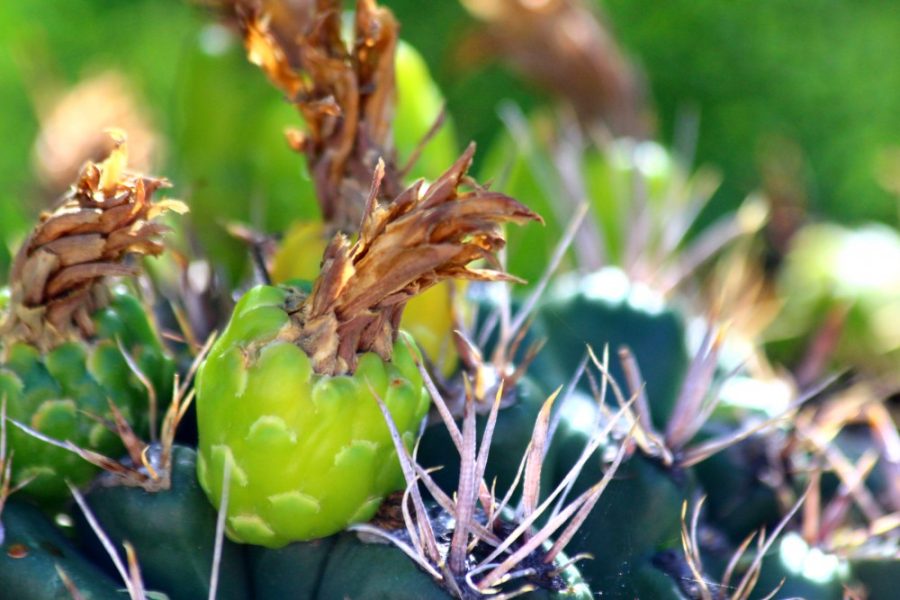Bearing the state flower of Arizona, the saguaro cactus remains an essential part of the Sonoran Desert’s identity. The 40-60 foot-tall saguaro and its fruit are great natural resources for both humans and wildlife alike.
A fantastic source of food for many desert animals and even humans, the saguaro cactus fruit serves as a link between humans and desert wildlife.
A very versatile cactus, the saguaro cactus and its fruit remain a true gem of the desert.
RELATED: Tree rings: The art and age of nature
“During the day, the saguaro is pollinated by the lesser long-nosed bat and the Mexican long-tongued bat and throughout the night, the saguaro’s flowers are pollinated by bees and the white-winged dove,” said Heidi Schewel, an alum of the UA who now works for the U.S. Forest Service.
Schewel said it is really amazing how the saguaro cactus has adapted to such arid conditions while remaining extremely useful for both humans and wildlife alike.
With such a surprisingly shallow root system, it stands wonders how the cacti can grow to such magnificent heights.
The saguaro’s white, fragrant flowers bloom for less than 24 hours. That means that it has a very short time to be pollinated.
“Bats are essential when it comes to the preservation of the saguaro,” said Bill Peachey a longtime Tucson-area geologist and independent scientist who studies saguaros.
Peachey said that his interest in nectar-feeding bats really sparked his interest in studying saguaros. Initially, Peachey studied the blooming of saguaro flowers and its anatomy.
Native to America, the saguaro and its fruit are an interesting and exciting part of the desert ecosystem that serve as food for many animals throughout the Sonoran Desert.
Without the saguaro, the Sonoran Desert would not be the same thriving ecosystem that it is today.
RELATED: The abundance of cacti in Tucson keeps the Sonoran Desert full of life and beauty
Peachey said the saguaro cactus fruit remains a high-energy food source for the bats. These nectar-feeding bats follow the blooming of the saguaro by flying to higher ground to pollinate the cactus. When they have finished pollinating the saguaros, they spend their winters in Mexico.
“The cactus fruit seeds are extremely tiny because they have to pass through the bat’s body to then spread the seed throughout the desert,” Peachey said.
The saguaro cactus fruit seeds are spread through animal droppings.
Peachey, who studied bat guano, has found that bats excrete an average of six cactus fruit seeds in each dropping, which helps spread the saguaro seeds around the desert.
Peachey said he has also seen a bat fly up to a saguaro, grab a cactus fruit and swallow it whole.
Walking into the Sonoran Desert, one can see that these saguaros are everywhere. They stand tall covering the mountains by providing food and shelter to many desert critters.
Schewel said that a major reason why there are so many saguaro cacti underneath mesquite trees is because that is where animals have left droppings full of cactus fruit seeds that have germinated and sprouted.
“The cactus fruits are very important for many animals,” Peachey said. “If the saguaro fruit runs out early, then the bats will eat prickly pears but only if they are split open.”
Peachey said that these pollinating bats are migratory which makes it very difficult for the wildlife community to count them.
“The saguaro was here before this was a desert, they are several million years old,” Peachey said. “There are more animals associated with the saguaro than any other plant in the desert.”
Schewel said that the Saguaro and its fruit are extremely unique to the Sonoran Desert and that people come from all over the world to see this cactus.
“Many living things eat the fruit of the saguaro,” Peachey said.
Likewise, sparrows will eat the fruit, and orioles will drink its nectar.
Peachey said that when the fruit of the saguaro falls to the ground, desert tortoises will eat them along with foxes and coyotes.
Humans even thrive off of the saguaro cactus fruit.
“The fruit can be used to make jellies, wine and even candy,” Schewel said.
The saguaro is more than just a food source, though — it is also home to many desert critters.
“Inside the saguaro there is a fleshy layer,” Schewel said. “Birds will build nests insides holes of the saguaro and this fleshy layer of the cactus provides insulation for the bird’s nests.”
Some species reliant on the saguaro, like the leaf-footed cactus bug, end up hurting the cactus.
“They hide on the scars of the saguaro and attack the cactus,” Peachey said. “No one knew this bug was out there for around 100 years.”
Schewel said that the Saguaro is truly a desert beauty.
“The saguaro blooms when nothing else does,” Peachey said.
Follow Sarah Briggs on Twitter.









